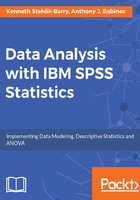
Frequency distributions
One of the analytic tools that you will make regular use of in SPSS Statistics is the ability to display the distribution of values for individual fields in your data.
The descriptive statistics shown in the preceding section are a convenient way to obtain an overview of the data but it is often necessary to see how many times each value is present in a set of data. This makes it possible to check the data in more detail and identify any potential issues.
To obtain a distribution of values for the Highest Year of School Completed field, navigate to the following path:
Analyze | Descriptive Statistics | Frequencies
Select this field from the list on the left, then click on OK to produce the table shown in the following image:

Given that the General Social Survey is conducted in the United States, the pattern in this table looks reasonable. The largest single group has a value of 12, which corresponds to the end of high school.
There is another sizeable group with 16 years of education, typically the time it takes to finish college. Understanding the US educational system allows us to check this data to see that it looks reasonable.
If data were collected from another country, we would expect a different distribution aligned with the structure to their educational system. In the Descriptive Statistics table screenshot, the mean for this field was shown as 13.74, which is useful information but not as detailed as what is provided in the Highest Year of School Completed table screenshot. The cumulative percentage column on the right, for example, shows the percentage that have 12 or fewer years of formal education (42.2%) as well as the percentage that have fewer than 16 years of education (68%) and both of these numbers provide some valuable information.